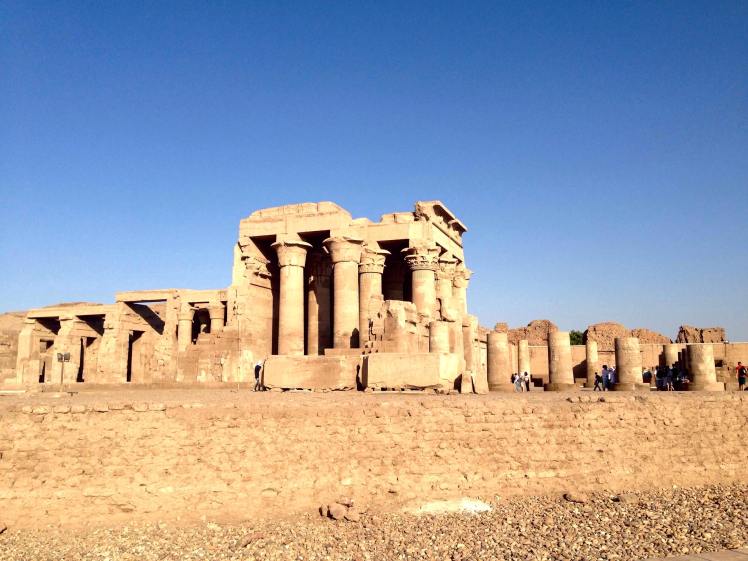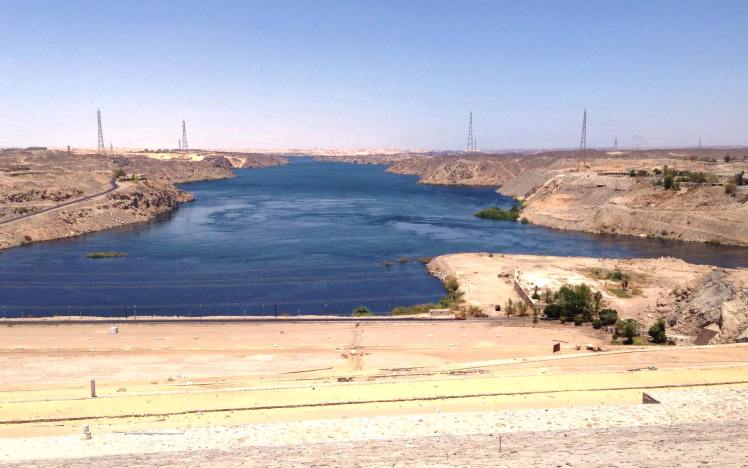Kom Ombo Temple

It is said that the Temple of Kom Ombo was built during the Graeco-Roman period (332BC – AD 395) whilst elements of its structure, the most derelict parts, date back to the 18th dynasty. It is these derelict parts that give the temple an outward skeletal appearance, impressing on my mind images of change, growth and continuous evolvement of not only the building’s structure but also that of the people and history associated with it. Thus, in its richness of history the temple gives a certain feel of prestige and import even in today’s society.
The temple’s imposing nature is appropriately named as ‘Kom’ in Arabic means ‘the small hill’ whilst ‘Ombo’, in the Hieroglyphic ancient Egyptian language means ‘the gold’. By looking into the meaning behind the temples name it becomes clear that the Egyptians considered the location to be ‘the hill of the gold’ with the ‘gold’ being the temple itself. Additionally, its prime location directly looks over the River Nile and thus suggests that the name speaks not only of wealth connected to the Pharaohs and gods but also to that of its economical and agricultural importance. Consequently, during the Ptolemaic period the River Nile and the Red Sea encouraged commercial activities within the Nile towns and thus became a central transit point used by many trading caravans.

Furthermore, the temple inspires awe from its unique double structure. By this I mean that the temple is dedicated to two ancient gods, Sobek the crocodile god and Horus the falcon-headed god. We can clearly see this from the layout of the temple which combines two temples in one with each side of the structure having its own gateways and chapels. I found the idea of paralleling the worship of these two gods interesting, especially as it I known that Sobek is associated with the wicked god Seth, the enemy of Horus.

The construction of the temple was mainly carried out in limestone in the shape of a rectangle which is similar to other Greco-Roman temples of the period. As you enter you are introduced to the front courtyard, then a hypostyle hall, flowing this there are three inner halls, two sanctuaries – one dedicated to Sobek and the other to the god Horus. When walking through these walls it struck me that the temple played the part of a maze, with a new delight at every corner. This is most evident in the seemingly never-ending halls – from the inner halls there are seven chambers; three of them situated in the eastern section whilst the others lie in the western part of the temple’s design. Furthermore, there are many antechamber and smaller rooms that were used for ritual purposes.
Despite feeling at times that the temple of Kom Ombo was too much for me in the sweltering heat, I am glad that I persisted in my adventure through its walls. There are wonderful carvings, unlike any I had ever seen before, depicting the Ptolemaic kings beating the enemies and presenting the offerings to the gods. it is magnificent to witness the Egyptians artwork and the care and detail they put into every line and curve. It is as if the act of depicting such scenes was a form of worship and an act of love and pride in the artists’ beliefs. There was also a sense of community, of something greater than oneself, even to the ignorant tourist like myself – a sense that by witnessing these pictures you were being welcomed into their rituals and lives. This wandering through the temple’s colonnades and gazing up at scenes of kingly propaganda gives you a glimpse of its glorious history for yourself.

Aswan Dam
The Aswan High Dam lies more than 2 miles long across the Nile River and at its crest is the massive $1 billion dam which thankfully ended the continuous cycle of flood and drought in the River Nile region. Due to its considerable size the dam exploits a large amount of energy – causing a rift of opinion amongst its people – some praising its benefits whilst others believe that it has had a negative environmental impact.

The dam took 11 years to construct and was finally completed in 1902. The first dam provided valuable irrigation during droughts but could not prevent the annual flood from the River Nile. In the 1950s, the Egyptian leader Gamal Abdel Nasser proposed building a new dam – one that was large enough to end flooding whilst also bringing electric power to every part of Egypt. Sadly, in 1956 the financial backing he once got from the United States and Britain was cancelled after learning of the secret Egyptian arms agreement with the USSR. This led to the well-known Suez Canal crisis, in which Nassar nationalised the canal in the hope of using tolls to pay for his High Dame project. In response Israel, Britain, and France attacked Egypt in a joint military operation.
Despite the Suez Canal being occupied the Soviet, US and UN forced Israel, Britain and France to withdraw, leaving the Canal in the hands of the Egyptians. Additionally, Soviet loans and the proceeds from the Canal tolls allowed Nasser to begin work on the Aswan Dam in 1960. Sadly he died in 1970, just 1 year before it was completed. In his honour, the giant reservoir created by the dam, which is 300 miles long and 10 miles wide, was named Lake Nasser.

The contention caused before and during the construction of the dam continued long after it was completed. The formation of Lake Nasser required the resettlement of 90,000 Egyptian peasants and Sudanese Nubian nomads and forced the relocation of the Abu Simbel Temple. This of course angered many whilst others considered its benefits – it ended the Nile’s devastating floods, reclaimed more than 100,000 acres of desert land for cultivation, made additional crops possible on some 800,000 other acres, whilst the Soviet-built turbines produce as much as 10 billion kilowatt-hours annually – all of which provide an enormous boost to the Egyptian economy.
It is true that perhaps the dam is not as awe-inspiring as other Egyptian sites but its history is just as rich and potentially more relevant. The negative effects of the dam which has decreased the fertility of agricultural lands in the Nile delta, spread the disease Bilharzia by snails that live in the irrigation system created by the dam and caused the reduction of waterborne nutrients flowing into the Mediterranean which consequently produced a decline in anchovy populations in the eastern Mediterranean, implores us to consider what is the length, the cost that we will go to, to maintain our supposed need for technological advancement. It is truly a thought-provoking place – one that I think everyone should visit once in their life and decide which side of the coin you stand on. Is it the side of the benefits of technological advancement or the fight against its negative environmental impacts?
Thanks for reading 🙂
X
This looks like such a great place to explore! The pictures you took are outstanding and it looks like there is some much culture and history to see.
LikeLiked by 1 person
Wow, resettling 90,000 people wouldn’t have been an easy task! I love that you included a little of the history as well as the photos though 🙂
– Jackie
LikeLiked by 1 person
Egypt is surely in my bucket list. I have listed this down every since 20 years ago. Hopefully, I can visit the country with my family in a few years. We would surely include ombo temple and aswan dam in our itinerary. 😀
LikeLiked by 1 person
I love Egypt and may be someday I’ll go there but this place looks like such a great place to explore! I loved the pics too..
LikeLike
First time to hear about all this historical facts, very informative! I’ll take note of all these, hoping I’d personally witness the grandeur that it is!
LikeLike
I went to Egypt many years ago in my early 20’s. I so regret not taking photos and wrote stuff about my travels to remember it by. Yes. I have one of the pyramids and the Sphinx but none like this. I honestly never thought. Memories fade. Photos do not (if properly stored lol)
LikeLiked by 1 person
What a fantastic read, the temple looks amazing. I would love to discover history like this. Would love to visit one day
LikeLiked by 1 person
Egypt is in my bucket list! I’m really interested to see the pyramids personally. It’s sad that the dam has many negative environmental impacts.
Like
One of my dreams is visiting places like this accompanied by an archeologist and anthropologist who could explain me every single step, sign, stone!
LikeLike
We so want to go to Egypt ! It looks gorgeous
We must say you have lovely pics here !
( Btw.. what font is your Headline written in ? We love it !!!! )
LikeLike
I so want to visit Egypt! Your pictures gave me a serious craving now! Who doesn’t love to explore history out there!
LikeLiked by 1 person
The limestone and history behind the ruins are fascinating. Your most has peeked my interest and encouraged me to long more about the temple.
LikeLike
The fact about re-settlers astonishes me. You ignited interest to read more about this temple.
LikeLike
I love visiting places that have so much history. The temple’s structure is absolutely beautiful!
LikeLiked by 1 person